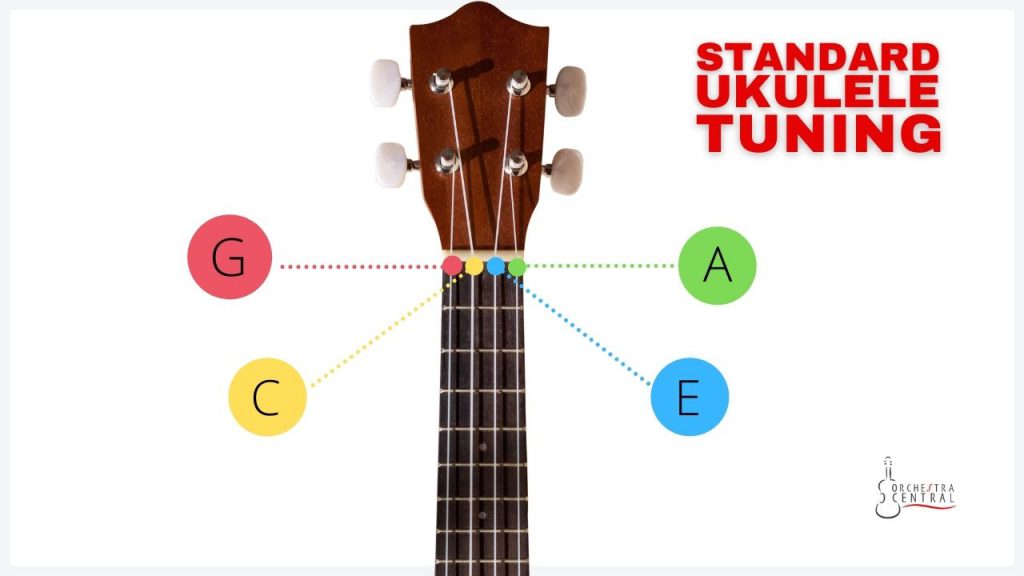Are you looking for a new hobby? Have you always wanted to learn how to play the ukulele, but never had the time or patience? Well, now is your chance! In this article, we are going to discuss ukulele tuning, including using a ukulele tuner.
So if you want some helpful advice on learning how to tune your ukulele correctly come on in!
What Is the Standard Ukulele Standard Tuning?

The standard ukulele tuning is G C E A (starting from the top to the bottom). Most songs and tabs have G-C-E-A tuning, making it the easiest ukulele tuning to master for beginners. You can also refer to the G-C-E-A as C tuning.
Note: Some people prefer to string their ukulele with a low G string rather than a high G string.
Other Types of Ukulele Tunings
There are a few different types of ukulele tunings that you can use.
Some people like to tune their instrument in D A E B, which is the same tuning as the highest four strings on your guitar (if tuned at E-A-D-G-B-E). Another popular option is C-G-E-A, where the first three strings sound lower while A is an octave higher. You can also tune your ukulele to F-Bb-Eb-Ab, but this one will take some getting used to!
Tenor Tuning
Tuning a ukulele tenor is similar to the G C E A, but with an exception. The G string has a higher pitch than the third string or C. And, yes, tenor tuning is similar to the soprano ukulele (more on this later). However, a tenor uke produces a fuller, richer, and lounder sound due to its larger size.
Soprano Ukulele Tuning
As mentioned, a soprano uke tuning will have a standard tuning (G C E A). Like the tenor tuning, a soprano tuning of a ukulele will have the G string at a higher pitch than C. That’s why many uke players also refer to soprano ukulele tuning as “high G on top.”
But why a higher G, you ask? A soprano ukulele is tuned to bring a brighter and happier sound, especially when strumming the strings.
If you want to lower the G and make the ukulele tuning as “low G on top,” you will have to use a G3 and a different string. Also, bear in mind that playing with a “low G on top” also means that you only have 1 ¾ octaves – with C4 as the lowest and A5 as the highest.
Baritone Ukulele Tuning
The baritone ukulele is tuned in the same way as a guitar, meaning it’s going to be very different from what you’re used to if you’ve only ever played soprano and concert ukes!
Baritones have strings with higher tension than your smaller-sized instruments, so they might take some getting used before you can play them comfortably. For a four-string ukulele, the baritone tuning is: D-G-B-E or G tuning
How to Use a Ukulele Tuner

There are two different ways you can tune your ukulele: electronically or by ear. The latter can be confusing and a challenge for beginner ukulele players. So, your best option (for now) is to use a physical chromatic ukulele tuner like a Fender FT-2 Professional Clip-on Tuner. You can also use our free online ukulele tuner if you want a quick and simple way to tune.
Electronic ukulele tuners may come in different sizes and shapes, but they are generally easy to use even for beginners. Here is how to use a ukulele tuner:
- Attach the ukulele tuner to your ukulele’s headstock.
- Pluck a string and the tuner will display the note it’s currently at.
- If the needle goes either to the left or the right, turn the string’s peg and adjust accordingly.
- After the adjusting the pleg, pluck the string again. If the needle lands on the center, then the string is in the right note.
Expert tip: Whenever you are tuning a ukulele, always start from the A string (or the 1st string). If you know how to play the piano, you can match the notes G, C, E and A with your ukulele.
Conclusion
Whether you prefer standard G-C-E-A or a high G on top, tuning a ukulele is not difficult! Plus, you can always use an electronic ukulele tuner to help you out. And, the best part? You can repurpose the tuner for other stringed instruments like guitars, bass, mandolins, and banjos!
Table of Contents






